Intel Core i5 3470 Review: HD 2500 Graphics Tested
by Anand Lal Shimpi on May 31, 2012 12:00 AM EST- Posted in
- CPUs
- Intel
- Ivy Bridge
- GPUs
HD 2500: Compute & Synthetics
While compute functionality could technically be shoehorned into DirectX 10 GPUs such as Sandy Bridge through DirectCompute 4.x, neither Intel nor AMD's DX10 GPUs were really meant for the task, and even NVIDIA's DX10 GPUs paled in comparison to what they've achieved with their DX11 generation GPUs. As a result Ivy Bridge is the first true compute capable GPU from Intel. This marks an interesting step in the evolution of Intel's GPUs, as originally projects such as Larrabee Prime were supposed to help Intel bring together CPU and GPU computing by creating an x86 based GPU. With Larrabee Prime canceled however, that task falls to the latest rendition of Intel's GPU architecture.
With Ivy Bridge Intel will be supporting both DirectCompute 5—which is dictated by DX11—but also the more general compute focused OpenCL 1.1. Intel has backed OpenCL development for some time and currently offers an OpenCL 1.1 runtime that runs across multiple generations of CPUs, and now Ivy Bridge GPUs.
Our first compute benchmark comes from Civilization V, which uses DirectCompute 5 to decompress textures on the fly. Civ V includes a sub-benchmark that exclusively tests the speed of their texture decompression algorithm by repeatedly decompressing the textures required for one of the game’s leader scenes. And while games that use GPU compute functionality for texture decompression are still rare, it's becoming increasingly common as it's a practical way to pack textures in the most suitable manner for shipping rather than being limited to DX texture compression.
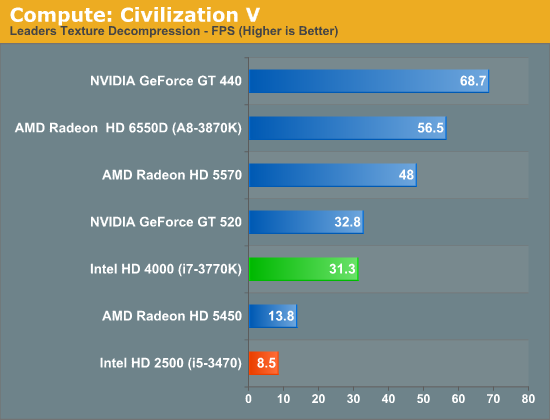
These compute results are mostly academic as I don't expect anyone to really rely on the HD 2500 for a lot of GPU compute work. With under 40% of the EUs of the HD 4000, we get under 30% of the performance from the HD 2500.
We have our second compute test: the Fluid Simulation Sample in the DirectX 11 SDK. This program simulates the motion and interactions of a 16k particle fluid using a compute shader, with a choice of several different algorithms. In this case we’re using an (O)n^2 nearest neighbor method that is optimized by using shared memory to cache data.
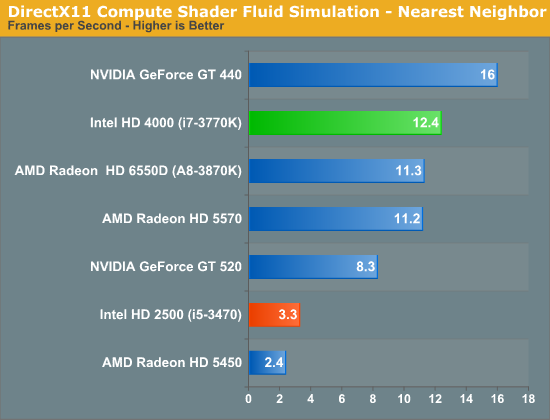
Thanks to its large shared L3 cache, Intel's HD 4000 did exceptionally well here. Thanks to its significantly fewer EUs, Intel's HD 2500 does much worse by comparison.
Our last compute test and first OpenCL benchmark, SmallLuxGPU, is the GPU ray tracing branch of the open source LuxRender renderer. We’re now using a development build from the version 2.0 branch, and we’ve moved on to a more complex scene that hopefully will provide a greater challenge to our GPUs.
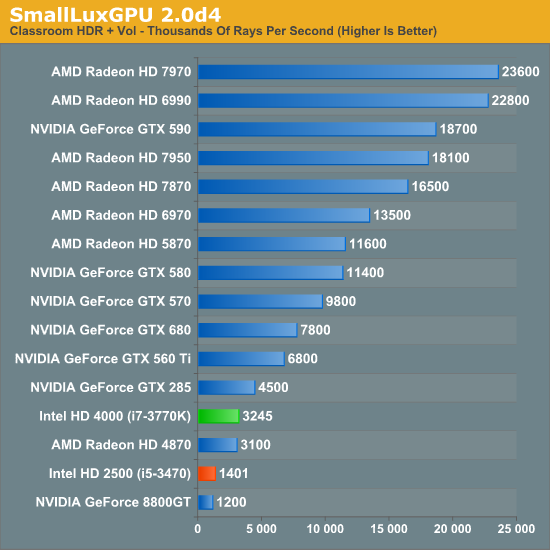
Intel's HD 4000 does well here for processor graphics, delivering over 70% of the performance of NVIDIA's GeForce GTX 285. The HD 2500 takes a big step backwards though, with less than half the performance of the HD 4000.
Synthetic Performance
Moving on, we'll take a few moments to look at synthetic performance. Synthetic performance is a poor tool to rank GPUs—what really matters is the games—but by breaking down workloads into discrete tasks it can sometimes tell us things that we don't see in games.
Our first synthetic test is 3DMark Vantage’s pixel fill test. Typically this test is memory bandwidth bound as the nature of the test has the ROPs pushing as many pixels as possible with as little overhead as possible, which in turn shifts the bottleneck to memory bandwidth so long as there's enough ROP throughput in the first place.
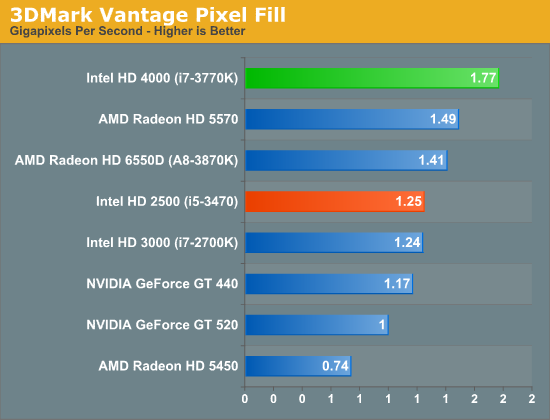
It's interesting to note here that as DDR3 clockspeeds have crept up over time, IVB now has as much memory bandwidth as most entry-to-mainstream level video cards, where 128bit DDR3 is equally common. Or on a historical basis, at this point it's half as much bandwidth as powerhouse video cards of yesteryear such as the 256bit GDDR3 based GeForce 8800GT.
Moving on, our second synthetic test is 3DMark Vantage’s texture fill test, which provides a simple FP16 texture throughput test. FP16 textures are still fairly rare, but it's a good look at worst case scenario texturing performance.
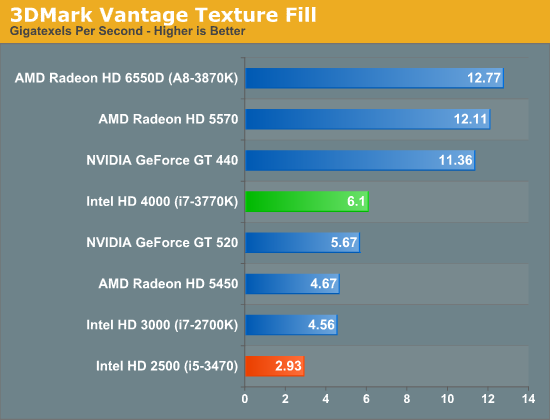
Our final synthetic test is the set of settings we use with Microsoft’s Detail Tessellation sample program out of the DX11 SDK. Since IVB is the first Intel iGPU with tessellation capabilities, it will be interesting to see how well IVB does here, as IVB is going to be the de facto baseline for DX11+ games in the future. Ideally we want to have enough tessellation performance here so that tessellation can be used on a global level, allowing developers to efficiently simulate their worlds with fewer polygons while still using many polygons on the final render.
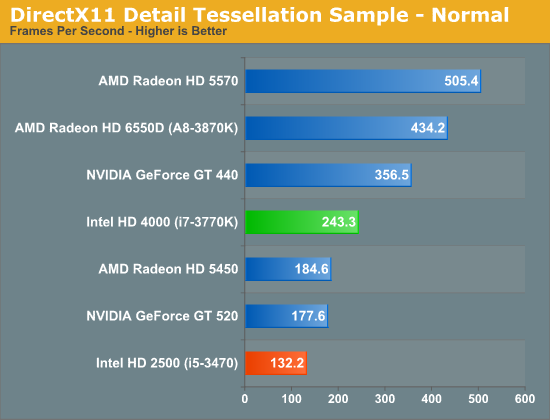
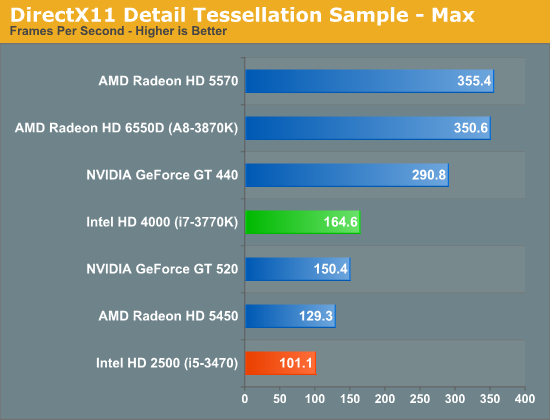
The results here are as expected. With far fewer EUs, the HD 2500 falls behind even some of the cheapest discrete GPUs.
GPU Power Consumption
As you'd expect, power consumption with the HD 2500 is tangibly lower than HD 4000 equipped parts:
| GPU Power Consumption Comparison under Load (Metro 2033) | ||||
| Intel HD 2500 (i5-3470) | Intel HD 4000 (i7-3770K) | |||
| Intel DZ77GA-70K | 76.2W | 98.9W | ||
Running our Metro 2033 test, the HD 4000 based Core i7 drew nearly 30% more power at the wall compared to the HD 2500.










67 Comments
View All Comments
MonkeyPaw - Thursday, May 31, 2012 - link
You can always go with the 2120T. It's only 35W (4 threads) and would beat the pants off the other 2 options you are considering.http://www.newegg.com/Product/Product.aspx?Item=N8...
nubie - Thursday, May 31, 2012 - link
I have to second the G620, they are damn cheap, about half the price of the 2120T, and you aren't losing any level 3 cache.SleepIT - Friday, June 15, 2012 - link
I use the mini-ITX Atom-based boards running Ubuntu/Webmin for NAS's (OS on thumbdrive, 4 x 2Tb drives on the latest). Performance is stellar!majfop - Thursday, May 31, 2012 - link
Upping the Turbo Boost multipliers for the 400 MHz overclock is only on Z75 and Z77, right? That makes it very much less "free" I would say.There seem to be some reasonable budget option B75 and H77 motherboards, not to mention the previous socket 1155 offerings with an updated BIOS to accept the IVB processor.
iwod - Thursday, May 31, 2012 - link
I sometimes wish Intel could just present a Lineup for OEM, another for Retail Consumers. To greatly simplify Lineup. Just looking at the Lineup Hurts my brain and eyes, they could just offer all CPU with HT, 2 / 4 Core Variants with Speed Differentiation would be MORE then enough for me.Then AMD is plain stupid for not capturing more market shares with their APU. Their new CEO has it right, where he had watched AMD systematically shoot itself in the foot, over and over again.
BSMonitor - Thursday, May 31, 2012 - link
It's ALL for OEM's. Retail CPU consumers are such a tiny fraction of the pie. Consumers just jump in where the CPU fits them best.The only consumer aimed retail products are the high end i7 hex-cores.
silverblue - Thursday, May 31, 2012 - link
Rory Read wasn't responsible for Fusion in any way; the only thing he can realistically do here is to push as many resources at getting APUs out of the door as possible.thunderising - Thursday, May 31, 2012 - link
One could have atleast hoped for HD3000 in a 200$ chip, not HD2500 crapShieTar - Thursday, May 31, 2012 - link
HD3000 is not 500 HDs better than HD2500, it is in fact an older, less capable version of HD graphics. The numbering scheme is admittedly silly, but thats to be expected from Intel by now.In the end, this CPU is not meant for gamers, not even if they want Ivy Bridge for a low cost. For 60$ less than the 3470 you will soon get the 2 core / 4 threads i3-3220. For a low budget gamer, this will still give you more than enough CPU power to team with any GPU you can afford. And those 60$ you saved can buy you an AMD 6670, which should be at least twice as fast as HD4000.
The 3470 makes much more sense for people that can accept minimal GPU power, but appreciate the increased CPU power of the (real) quadcore. Think office PC handling massive excel files with loads of calculations: Not enough to warrant a Xeon based system, but definitly enough to make the 60$ premium from a dual core worthwhile.
CeriseCogburn - Monday, June 11, 2012 - link
The idea that any poor sap has to game on any 2000, 2500, 3000, or 4000, or llano, or trinity, is too much to bear.What a PATHETIC place to be. How the heck is someone going to spend on HD3000 or HD4000 and the board and accompanying items and not have $75-$100 for say a GTX460 ?
I mean how badly do these people plan on torturing themselves and what point are they really trying to prove ?
They could get a $100 amd phemon 2 and a $100 GTX 460 if they want to game, and be so far ahead...
This whole scene is one big bad freaking JOKE.